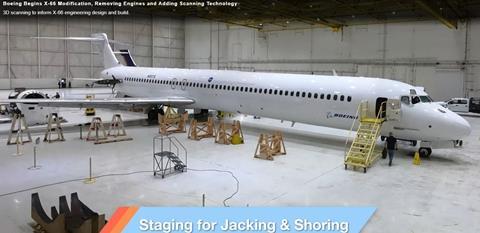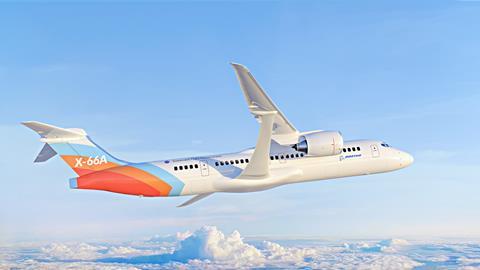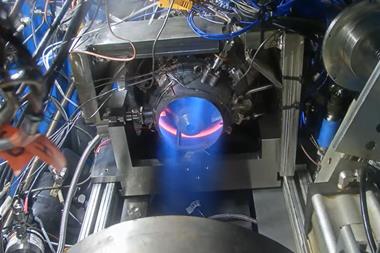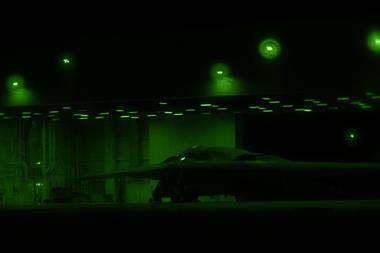Boeing has started dismantling and scanning an old MD-90 as part of a multi-year NASA-supported project to transform the former passenger jet into the X-66A truss-braced-wing demonstrator.
Since the jet arrived at a Palmdale, California hangar last August, Boeing’s team has removed the MD-90’s twin International Aero Engines V2500 turbofans and completed optical and laser scans of the aircraft, Boeing says on 8 January.
The work has just started. Boeing and its partners will now spend several years removing the jet’s wings and 19 fuselage sections before equipping it with Boeing’s “transonic truss-braced wing”. First flight of X-66A is targeted for the third quarter of 2028.
Part of NASA’s Sustainable Flight Demonstrator programme, the effort aims to validate that the wing can significantly improve fuel efficiency. But X-66A could be used to test other fuel-saving technologies.

“Boeing has begun extensive modification of an airplane that will become the X-66 Sustainable Flight Demonstrator, removing engines and completing 3D metrology scans to inform the plane’s design and build plan,” the company says.
On 8 January the company also released a time-lapse video depicting modifications to date, including removal of the MD-90’s engines, “jacking and shoring of the jet” and scanning. Boeing manufactured the MD-90 (registration N931TB) in 1999 and acquired it from Delta Air Lines, Cirium fleets data shows.
Boeing’s truss-braced wing, to be mounted atop the MD-90’s fuselage, will be highly flexible and much longer than traditional jetliner wings, requiring it be supported by trusses. That extra length and increased aspect ratio (which denotes the relationship between a wing’s span and area) should generate less drag than traditional wings.
NASA has estimated truss-braced wings could make a future new narrowbody jetliner 10% more efficient than current aircraft, with other technological advancements bringing total potential efficiency gains to 30%.
Long, flexible wings can pose aero-elasticity challenges – they can bend and distort in flight, increasing drag and potentially causing flutter.
But Boeing’s Sustainable Flight Demonstrator programme manager Eric Kaduce says the wing’s support structure mitigates those issues. “The strut is very effective [in] supporting the wing. Aero-elastics and flutter are certainly something that we will be spending a lot of time and attention on, but it’s not something that is of great concern.”
Boeing subsidiary Aurora Flight Sciences is manufacturing the X-66A’s composite-material wing in West Virginia. The wing will be shipped to Palmdale.
It will have fly-by-wire controls but Boeing will retain the MD-90’s mechanical-cable system that controls its rudder and elevator, Kaduce says.
Boeing has said a truss-braced airliner could fly Mach 0.8. It calls the wing “transonic” because at that speed some air flowing around the aircraft’s airfoils will meet or exceed M1.
“Our goal is to validate the architecture, learn about the new and novel elements of the configuration, so that we can better inform future product strategy,” Kaduce says. X-66A can help Boeing demonstrate tools and methods related to computational fluid dynamics, finite-element analysis and structural-joint-architecture analysis.

WORKING TOWARD 2028 FLIGHT
Boeing, as the aircraft manufacturer (through its 1997 combination with McDonnell Douglas), knows everything there is about new-build MD-90s.
But decades of carrying passengers can change much about a jet’s condition. The team must therefore complete detailed scans to understand its current state prior to making larger structural changes.
“We have to have a really solid understanding of the existing structure in order to be able to ensure that the new wing gets installed appropriately from an aerodynamic perspective, and meets the requirements of the programme,” says Claire Rosenlof, Boeing’s X-66A director of modification and manufacturing operations.
To allow more time for scanning, Boeing flew the aircraft to Palmdale in August last year, scrapping a previous plan to fly it there in 2024.
In 2025, the company anticipates starting more “teardown activity, in order to gain access to all the major structural components that we’re going to be modifying,” says Rosenlof. The team will remove the MD-90’s wing outboard of the landing gear pylons, and remove 19 fuselage sections to shorten it by several feet. Kaduce notes that those 19 frames are the same frames McDonnell Douglas added to the MD-80-series aircraft to create the stretched MD-90.
X-66A must be shorter because Boeing removed the aft-mounted engines and will install new powerplants under its wings, changing the centre of gravity.
Those engines will be twin Pratt & Whitney geared turbofans (GTF), which Kaduce calls “perfectly matched from a thrust-class perspective” to X-66A.
Speculation has abounded that Boeing could later use X-66A to test a new engine design, such as the open-rotor engine CFM International is developing under its Revolutionary Innovation for Sustainable Engines (RISE) programme. Indeed, Boeing chief executive David Calhoun said last year that X-66A’s high-wing configuration could be ideal for an open rotor.
In mid-2026 or 2027, Boeing anticipates completing what Rosenlof calls “the predominance of structural modification, which is really setting the centre section up to receive the new wing”.
“We’ll be adding critical components of structure to take those new load paths, [and] reinforcing some of the existing structure on the airframe in order to accommodate that new wing,” she says.
The work requires modifying the top and bottom of the jet’s fuselage, and its landing gear.

First flight, scheduled for 2028, will kick off what Boeing anticipates will be a nine-month flight-test programme, though flight-test details remain unsettled, says Kaduce.
NASA last year awarded Boeing the contract to develop X-66A under a “funded Space Act agreement”, notes NASA Sustainable Flight Demonstrator programme manager Brent Cobleigh.
That funding mechanism (never previously used by NASA’s aeronautics division) is unique because it aims to advance goals deemed to be in the public’s interest. The deal requires significant financial commitment from industry and does not involve NASA actually acquiring X-66A. It will remain Boeing’s aircraft, says Cobleigh.
The agreement also does not set out a long list of exacting technical specifications but rather leans on Boeing to develop technologies to “dramatically reduce aircraft fuel burn”, NASA documents note.
“NASA is not leading it from the perspective of defining every element of the research, or even how to do it,” Cobleigh says.
NASA has committed $425 million to X-66 development over seven years and will grant X-66A’s airworthiness approval. Industry partners will pay the balance of the programme’s estimated $1.15 billion development expense, with Boeing’s financial commitment topping NASA’s, he adds.
Technical experts from the agency are embedded in Boeing’s teams. it’s responsibilities also include stress testing the wing’s struts, and the team will use NASA’s wind-tunnel facilities.
NASA hopes the project will help Boeing determine if truss-brace wings are operationally and economically feasible. If so, the agency hopes Boeing’s next narrowbody jet – the 737’s replacement – will have the wing.
“If we really want this technology to make it to market, we shouldn’t be telling industry how to do it,” Cobleigh says. “Boeing is leading this effort.”



































